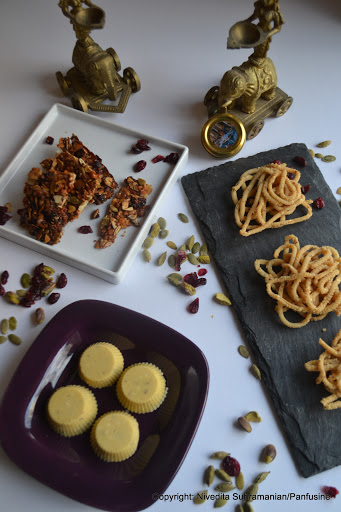Category Archives: Garbanzo
Recreating flavors (or at least trying) – White turnip stew with toasted Chana dal.
Turnip ‘Kootu (Stew) with toasted Channa Dal
Diwali Traditions – Okkarai revisited
Its a refreshing change to get back into the obsessive cooking mode after an extended slump brought about by a general saturation of food related over stimulation of the nervous system. At the same time I realize that since 2010, over three Diwali celebrations I may just have ended up ‘panfusining’ most of the traditional dishes that my family generally serves up. Here’s a recap:
Maa Ladoo: An unbelievably simple confection consisting of fresh ground Garbanzo flour, sugar and ghee flavored with a touch of Cardamom & Saffron.
Lehiyam Truffles: The traditional antidote to heavy Diwali indulgence.
Hazelnut and Almond ‘Cake’ : A burfi using hazelnuts, something that does not figure in any Indian Dishes.
and somethings that are great just the way mommy made them, like the rice chakli known as ‘Vella Thenkozhal’
Okkarai health bars was one of my earliest experiments for Panfusine and there was a phase when I kept making batch after batch at such regular intervals and got to the point when I never wanted to see, smell or even hear about the dish.. took me a year and a half to get over it just in time for a revised version with some contrasting ingredients for added color.
Here is the recipe for the redux. Thisversion is absolutely no ghee involved and makes for a great healthy vegan treat. I used a coconut Palm jaggery, an ingredient borrowed from Thai cuisine. This kind of jaggery is comparatively more soft, and has a viscous consistency. Its perfect for pouting out into the pan. If you’re using regular sugar cane jaggery, just make sure you powder the blocks before measuring out the amount you need.
Okkarai Health Bars:
You need:
1 cup dried Split garbanzo beans (channa dal)
1 cup shelled pumpkin seeds
1/2 cup sliced almonds
1/2cup dried sweetened cranberries
1 cup jaggery, crumbled
1 cup dark brown sugar
1 teaspoon powdered cardamom.
Preheat the oven to 275 F.
Line a 15 x 10 inch baking sheet with parchment paper.
Toast the split garbanzo beans until golden. Add to a container containing scalding hot water. set aside for about 2-3 hours or preferably overnight for the beans to soften. Drain the water and and add the garbanzo into a food processor. Pulse until the mixture breaks up into a very coarse consistency. Transfer into a large mixing bowl.
Lightly toast the pumpkin seeds and sliced almonds and add them to the garbanzo along with the dried sweetened cranberries. Add the cardamom and toss to blend.
Combine the jaggery and the sugar and heat gently until the mixture melts and forms a syrup. When the syrup reaches a ‘soft crack’ (the syrup forms thin malleable threads when dropped into cold water) stage, add the scalding hot sugar syrup into the garbanzo and nut mixture. Fold to evenly coat the syrup around the mixture.
Spread the mixture evenly on the baking sheet,
Slide the baking sheet into the oven and bake at 275 F for about 25 minutes until the edges begin to caramelize. Switch off the oven and allow the okkarai to rest in the oven itself for about 10 minutes. Remove and score with a sharp knife and cut into bars. Allow the baking sheet to completely cool over a wire rack before breaking up the pieces. Store in an airtight jar.
Bon appetit!
Wishing everyone a very happy Diwali and prosperity filled year ahead!











